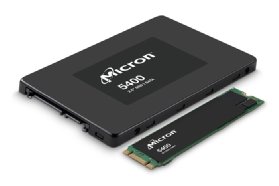
Getty Images
Micron releases first 176-layer NAND SATA SSD
Micron brings high endurance, lower costs and continued support for the SATA interface with the release of its new 5400 SATA SSD for the data center.
With Micron's next-generation NAND technology released in a legacy interface, the memory storage provider assures customers that SATA SSDs are here to stay.
The Micron 5400 uses the company's 11th-generation, 176-layer, triple-level cell NAND. The new SSDs act as either HDD replacements or flash storage with a longer lifecycle and a potentially lower price.
The SATA interface is legacy technology that gets less attention than the newer NVMe interface; however, SATA isn't going away anytime soon, according to Greg Wong, founder and analyst at Forward Insights. The technology has proved to be resilient with OEMs and cloud providers that still use it for boot drives.
"Micron and others are going to continue to support SATA on the latest NAND technology," Wong said.
SATA SSDs are still shipping in the range of 20 million units per year, equated to 26 to 28 exabytes through 2025, according to Forward Insights' "SSD Insights Q2/22" report.
Layers of benefits
Taking the SATA SSD technology to 176 layers is significant in terms of adding innovative technology to a legacy drive, Wong said. This adds a longer lifetime to SATA, where just a few years ago, it was expected to be replaced by the more modern interfaces like PCIe and NVMe.
The additional layers won't change performance, as the SATA interface limits maximum performance, Wong said. Micron highlighted a slight performance increase in mixed-use workload writes with a high of 96,000 IOPS, achieved through NAND timing optimizations and error suspends.

From a cost perspective -- what it costs Micron to produce the drive -- there should be roughly a 30% reduction, Wong said. This will get passed on to the customer in some form.
"The price may not go down 30%, but I think costwise it should be 30% cheaper [for Micron]," Wong said.
This is one of the factors taken into consideration for OEMs that look to use the 5400 SATA SSD primarily for server storage, he said. The market is essentially split between three main SSD vendors: Micron, Samsung and Solidigm. OEMs will source from all three suppliers, and buy depending on price and support.
Enduring legacy technology
According to Micron, the 5400 has 50% greater reliability than the competition through a higher mean time to failure (MTTF). Micron states a MTTF of 3 million hours, which is fairly high, Wong said. Solidigm offers MTTF of 2 million hours on its D3-S4620 SSD.
This combined with the 5400's five-year warranty are selling points for customers needing higher endurance, Wong said.
Micron did point out that the previous version, the 96-layer Micron 5300 SATA SSD, also had an MTTF of 3 million hours.
The Micron 5400 SATA SSD family is available now in M.2 2280 form factor for boot drives and 2.5-inch form factor with capacity ranging from 240 GB to 7.68 TB.







